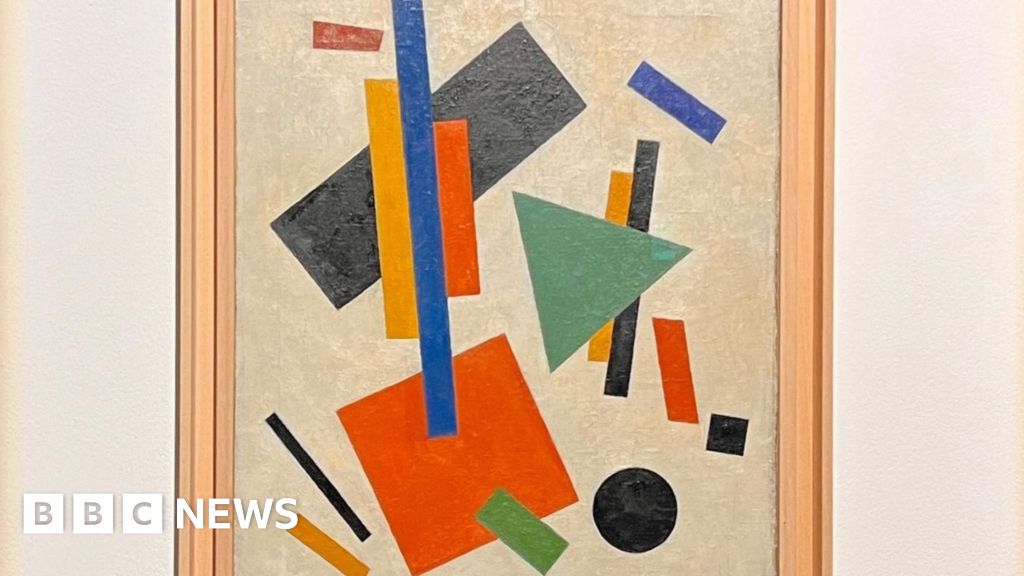Introduction to a Mysterious Art Discovery
Three previously unknown oil paintings attributed to the famous avant-garde artist Kazimir Malevich are on display in a public museum in Bucharest. If proven authentic, these paintings could be worth over 100 million pounds. However, a top scholar has expressed skepticism about the story behind their origin.
The Story Behind the Paintings
The paintings were allegedly discovered under the mattress of Israeli pensioner Eva Levando during a house move in 2023. Levando’s grandson-in-law, Yaniv Cohen, now owns the works and claims that they were given to him by his wife’s grandmother. The paintings are titled Suprematist Composition with green and black rectangle (1918), Cubofuturist composition (1912–13), and Suprematist composition with Red Square and Green Triangle (1915–16).
Skepticism in the Art World
The art world remains skeptical about the authenticity of the paintings. Konstantin Akinsha, a Ukrainian-American scholar, told the BBC that there is no documentation or records of the paintings during Malevich’s lifetime. Akinsha also questioned the lack of evidence that Malevich’s works were in circulation in the Russian or Ukrainian art markets during the late 1920s and early 1930s.
The Role of Stalin
According to Cohen, the lack of records is due to the repression of modernist art during the Stalin era. He claims that Levando’s father, an accountant in Odesa, bought one of the paintings and received the other two as payment for his services. However, Akinsha argues that there is no evidence to support this story and that Malevich’s own records do not mention private sales after 1917.
Authentication and Expert Opinion
Cohen presented certificates from Kyiv art historian Dmytro Horbachov, who describes the works as "first-class examples" of Malevich’s style. However, Horbachov has previously authenticated controversial works, and his expertise has been questioned. The art historian claims to be a consultant for Sotheby’s and Christie’s, but both auction houses deny any formal association with him.
Technical Analysis
Technical analysis of the paintings was conducted by the Institut d’Art Conservation et Couleur in Paris and the German laboratory of Elisabeth Jägers and Erhard Jängers. While the analysis dated the pigments and other elements to Malevich’s lifetime, it did not confirm that the works were painted by the artist. The laboratories have previously accompanied reports on counterfeits in a BBC documentary, and Erhard Jägers stated that technical analysis cannot prove the authenticity of a painting.
The Market for Russian and Ukrainian Modernist Art
The market for Russian and Ukrainian modernist art is filled with works that are "obviously problematic," according to Reto Barmettler, a consultant on Russian paintings for Sotheby’s. Barmettler explained that good avant-garde paintings do not come out of nowhere and should have a documented origin and exhibition history.
The Museum’s Response
After Akinsha questioned the origin of the paintings, the Romanian National Museum of Contemporary Art (MNAC) distanced itself from the works. The museum called the exhibition a "curatorial experiment" and stated that there were no experts to authenticate the paintings. The museum also said that the inclusion of Cohen’s paintings in the exhibition should not be interpreted as an institutional confirmation of their authorship or authenticity.
The Bigger Picture
Konstantin Akinsha believes that the case of the three paintings is just the "top of the iceberg" and that thousands of questionable works continue to circulate today. The lack of transparency and documentation in the art market makes it difficult to verify the authenticity of works, and the case of the Malevich paintings highlights the need for greater scrutiny and expertise in the field.

